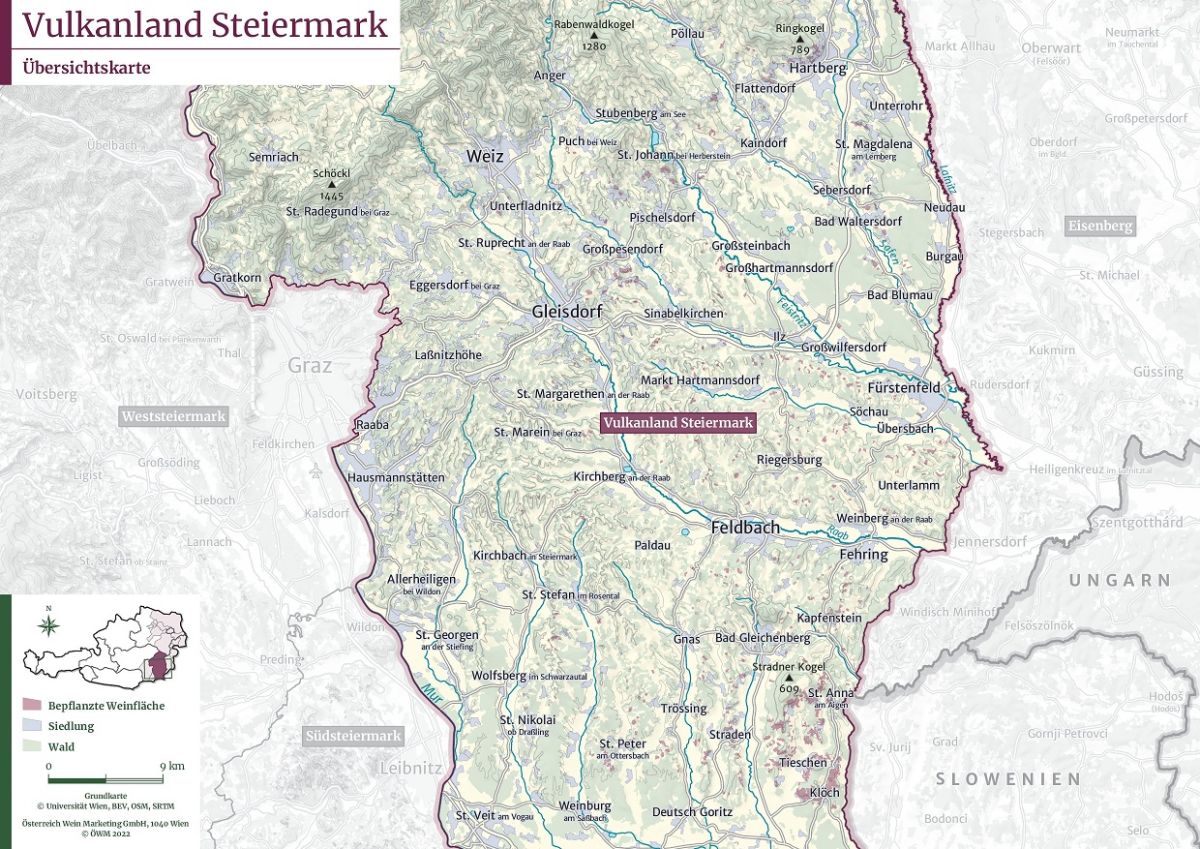Vulkanland Steiermark
One of the three specific wine-growing regions in the Austrian province or generic wine-growing region of Styria. It lies close to the borders with Slovenia and Hungary, as well as Burgenland. The area formerly known as south-east Styria was renamed Vulkanland Steiermark in 2016. It is also known as the "Land of Castles and Palaces".

Climate & soils
In the north, there are vineyards at 650 metres above sea level on the Ringkogel near the municipality of Hartberg, which are among the highest vineyards in Austria. Climatically, this is a transition zone between the hot, dry Pannonian climate with little rainfall and the warm, humid Mediterranean climate. Volcanic soils with sandy loam, clay and weathered basalt predominate. The towering volcanic cones characterise the landscape and also gave it its new name. The two large vineyards are called Oststeirisches Hügelland and Steirisches Vulkanland.

Wine-growing communities
Four wine routes lead through the landscape characterised by gentle hills. Well-known wine-growing communities are Bad Radkersburg, Feldbach, Gleichenberg, Gleisdorf, Hartberg, Kapfenstein (vineyards An der Kapelle, Hinteregg, Rosenleiten), Klöch with the speciality "Klöcher Traminer", Riegersburg (vineyards Brunnenfeld, Festungsmauer, Turnierplatz), St. Anna am Aigen, St. Peter, Straden (vineyards Buchberg, Klausen), St. Anna am Aigen, Tieschen and Weiz. These are connected by the Klöcher Wine Route, Thermenland Wine Route, South-East Styrian Hill Country Wine Route and East Styrian Roman Wine Route.
Grape variety index
In 2022, the vineyards covered a total of 1,657 hectares of vines. Compared to 2016 with 1,524 hectares, this was an increase of 133 hectares (9%). White wine varieties account for 1,408 hectares (85%) and red wine varieties for 249 hectares (15%). Welschriesling dominates the white wine varieties, followed by Pinot Blanc and Sauvignon Blanc. The red wine varieties are dominated by Zweigelt, followed by Blauer Wildbacher and Merlot. The Muscaris, Muscat, Sauvignon Blanc, Souvignier Gris and Pinot Blanc varieties were promoted, while Müller-Thurgau and Blauburger were relegated.
Grape variety
|
in Austria
|
colour |
HA
|
%-Ant
|
HA
|
%-Ant
|
| Welschriesling | - | white | 319 | 19,2 | 310 | 20,3 |
| White Burgundy | Pinot Blanc, Klevner | white | 291 | 17,6 | 240 | 1507 |
| Zweigelt | Blauer Zweigelt, Rotburger | red | 146 | 8,8 | 177 | 11,6 |
| Sauvignon Blanc | Muscat Sylvaner | white | 173 | 6,4 | 108 | 7,1 |
| Muscat | Yellow M., Red M. / Muscat Blanc | white | 138 | 8,3 | 66 | 4,3 |
| Chardonnay | Morillon | white | 113 | 6,8 | 93 | 6,1 |
| Müller-Thurgau | Rivaner | white | 76 | 4,6 | 103 | 6,8 |
| Grey Burgundy | Pinot Gris,... |
Voices of our members

Serious sources on the internet are rare - and Wine lexicon from wein.plus is one such source. When researching for my articles, I regularly consult the wein.plus encyclopaedia. There I get reliable and detailed information.
Thomas Götz
Weinberater, Weinblogger und Journalist; Schwendi